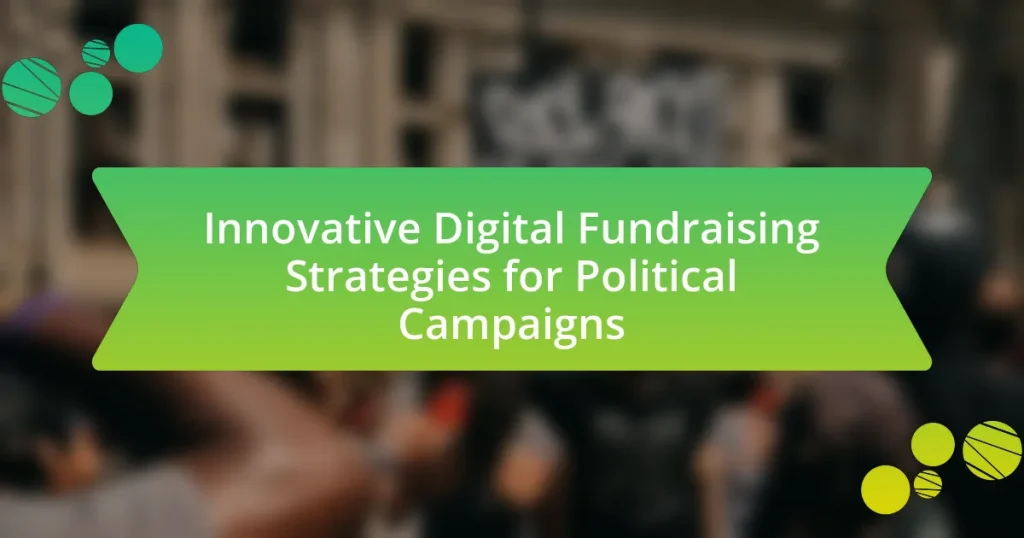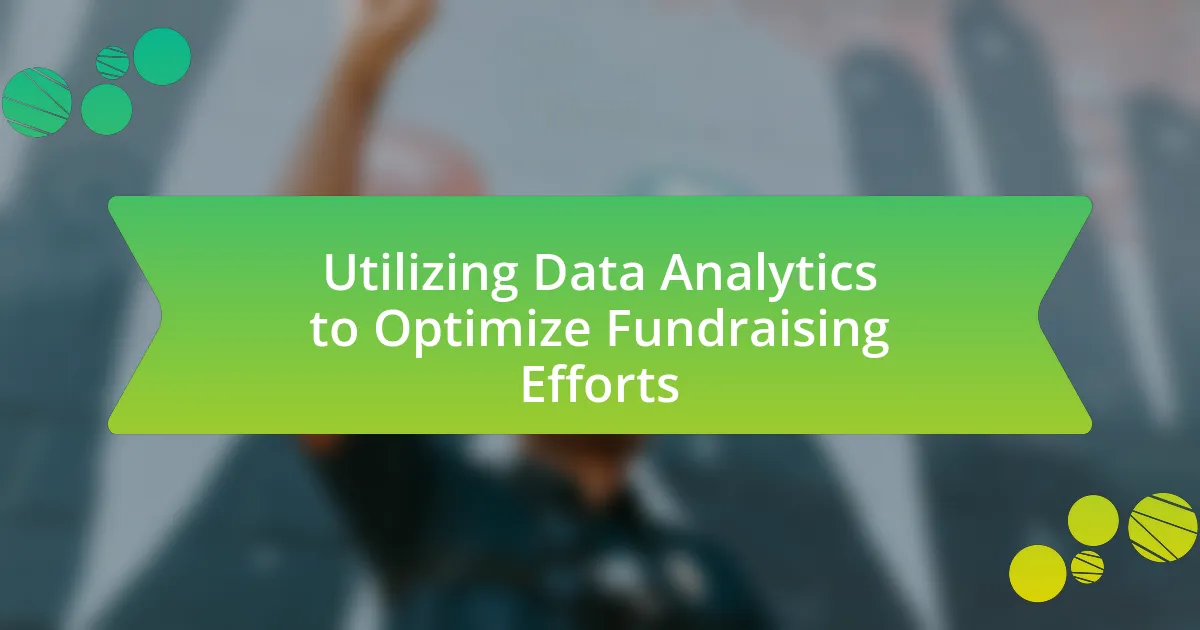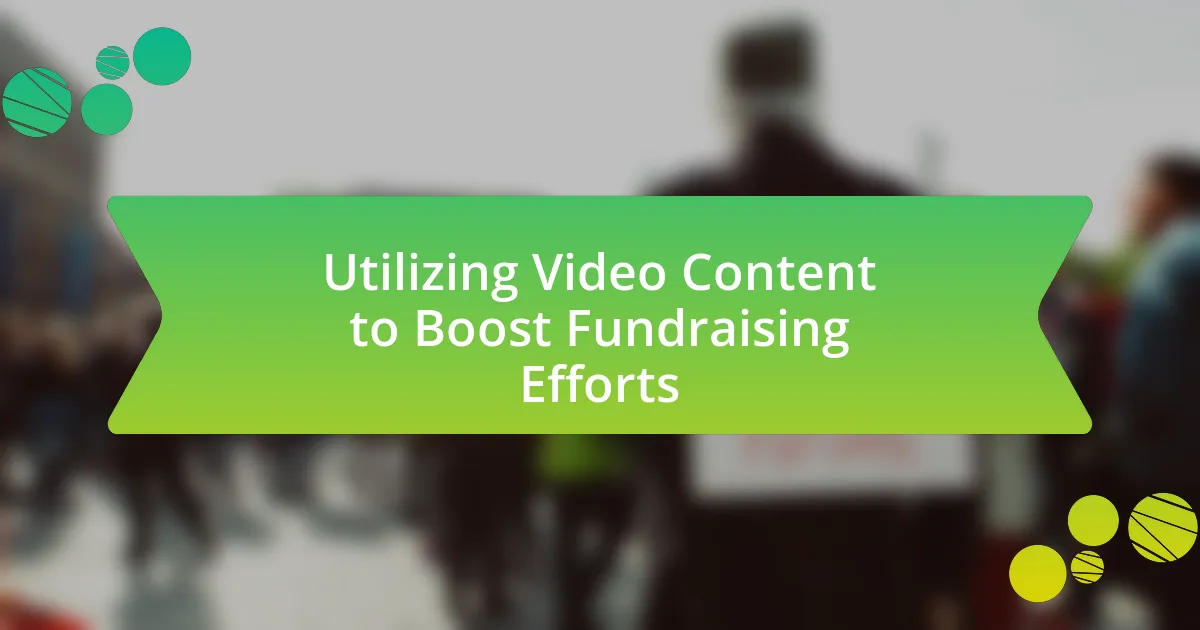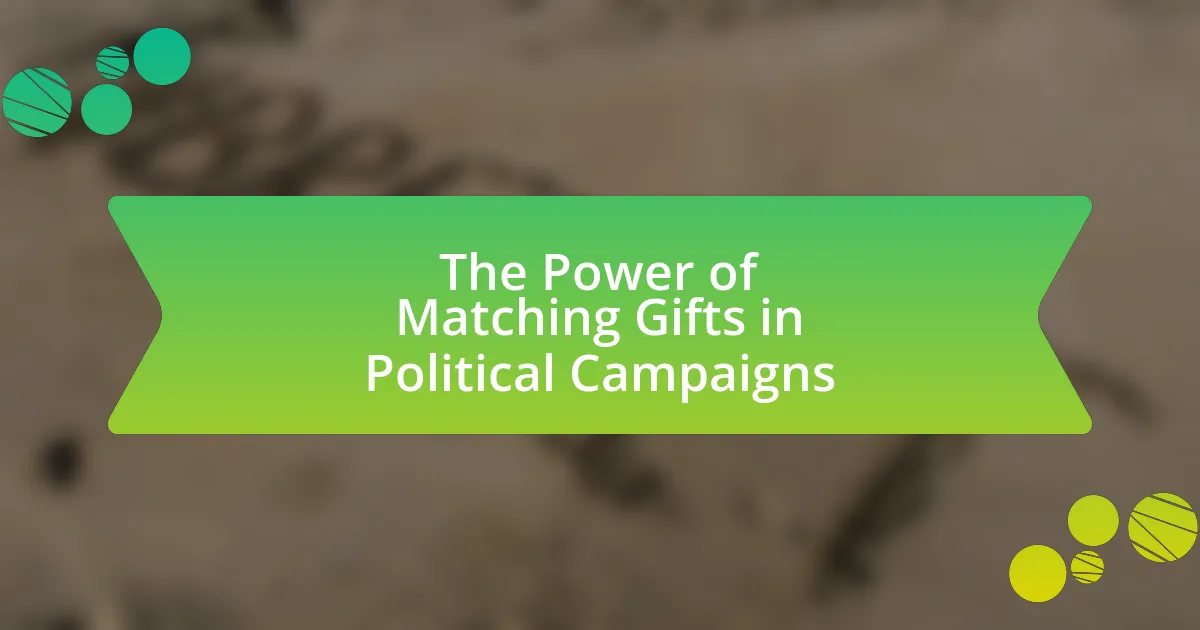Innovative digital fundraising strategies for political campaigns are essential for engaging voters and securing financial support. Key methods include leveraging social media platforms for direct engagement, utilizing crowdfunding to gather small-dollar donations, and implementing data-driven targeting to optimize outreach. These strategies differ from traditional fundraising by employing technology and analytics to reach broader audiences efficiently. The article explores the impact of demographic shifts, technological advancements, and best practices for successful digital fundraising, while also addressing challenges such as donor fatigue and data privacy concerns. Additionally, it highlights the importance of transparency and ethical considerations in building trust with donors.
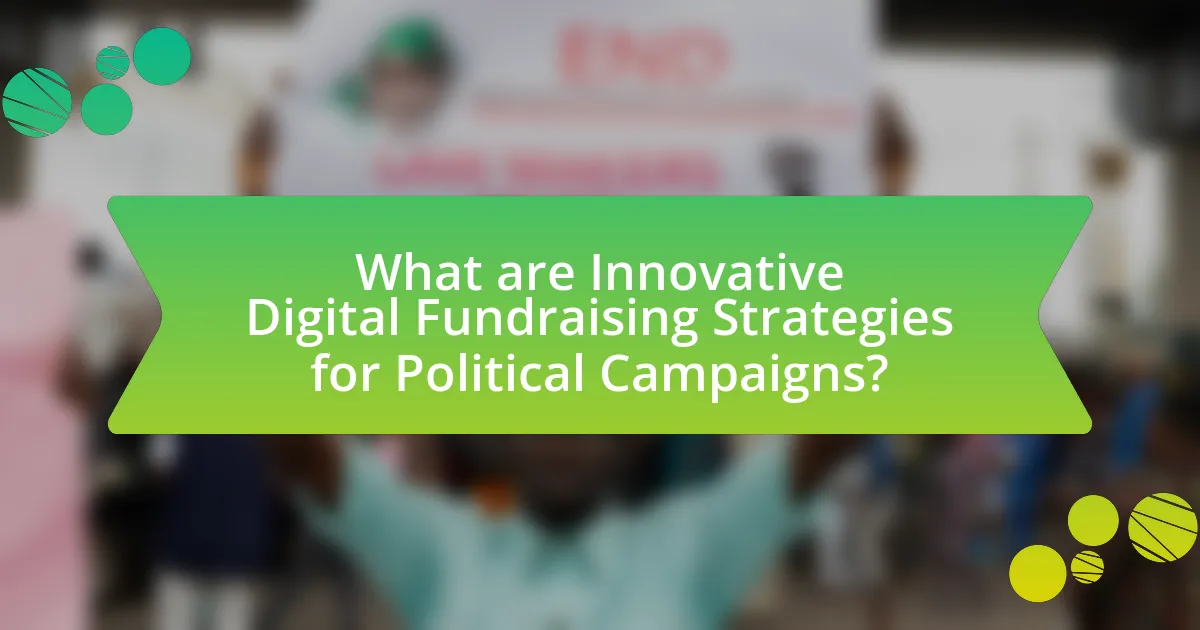
What are Innovative Digital Fundraising Strategies for Political Campaigns?
Innovative digital fundraising strategies for political campaigns include leveraging social media platforms, utilizing crowdfunding, and implementing data-driven targeting. Social media platforms like Facebook and Twitter allow campaigns to engage directly with voters, facilitating small-dollar donations through targeted ads. Crowdfunding enables campaigns to raise funds from a large number of supporters, exemplified by the success of platforms like ActBlue, which has processed billions in donations for Democratic candidates. Data-driven targeting enhances fundraising efforts by analyzing voter behavior and preferences, allowing campaigns to tailor their messaging and outreach effectively. These strategies have proven effective, as evidenced by the 2020 U.S. presidential election, where digital fundraising played a crucial role in campaign financing, with candidates raising unprecedented amounts online.
How do these strategies differ from traditional fundraising methods?
Innovative digital fundraising strategies differ from traditional fundraising methods primarily in their use of technology and data analytics to engage donors. Traditional methods often rely on face-to-face interactions, direct mail, and events, which can be time-consuming and limited in reach. In contrast, digital strategies leverage online platforms, social media, and targeted advertising to reach a broader audience quickly and efficiently. For example, a study by the Pew Research Center found that 69% of adults in the U.S. use social media, providing a vast pool for campaigns to engage potential donors. Additionally, digital fundraising allows for real-time data collection and analysis, enabling campaigns to tailor their messaging and outreach based on donor behavior and preferences, which is not feasible with traditional methods.
What technological advancements have influenced these strategies?
Technological advancements such as social media platforms, mobile payment systems, and data analytics have significantly influenced innovative digital fundraising strategies for political campaigns. Social media platforms like Facebook and Twitter enable campaigns to reach a broader audience quickly, facilitating grassroots fundraising through targeted ads and viral content. Mobile payment systems, including apps like Venmo and Cash App, streamline the donation process, allowing supporters to contribute instantly from their smartphones. Data analytics tools provide campaigns with insights into donor behavior and preferences, enabling personalized outreach and more effective fundraising strategies. These advancements collectively enhance engagement, increase donation efficiency, and optimize campaign resources.
How do demographic shifts impact the effectiveness of these strategies?
Demographic shifts significantly impact the effectiveness of innovative digital fundraising strategies for political campaigns by altering the target audience’s preferences and engagement methods. For instance, as younger generations, who are more tech-savvy and prefer digital communication, become a larger portion of the electorate, campaigns must adapt their strategies to utilize social media platforms and mobile-friendly donation processes. Research from the Pew Research Center indicates that 95% of adults aged 18-29 use smartphones, highlighting the necessity for campaigns to optimize their digital outreach to engage this demographic effectively. Additionally, shifts in racial and ethnic demographics can influence messaging and outreach strategies, as diverse groups may respond better to tailored content that reflects their unique experiences and values. Therefore, understanding and responding to these demographic changes is crucial for maximizing the impact of digital fundraising efforts in political campaigns.
Why is digital fundraising crucial for modern political campaigns?
Digital fundraising is crucial for modern political campaigns because it enables candidates to reach a broader audience and secure funding more efficiently. In 2020, over 60% of campaign contributions in the United States were made online, highlighting the shift towards digital platforms for fundraising. This method allows for real-time engagement with supporters, facilitating small-dollar donations that can accumulate significantly. Additionally, digital fundraising tools provide data analytics that help campaigns tailor their messaging and outreach strategies, enhancing overall effectiveness.
What role does social media play in digital fundraising?
Social media plays a crucial role in digital fundraising by providing platforms for outreach, engagement, and mobilization of supporters. These platforms enable political campaigns to connect with a broader audience, facilitating real-time communication and fostering community among potential donors. According to a report by the Pew Research Center, 69% of adults in the U.S. use social media, making it an essential tool for campaigns to reach and influence a significant portion of the electorate. Furthermore, social media allows for targeted advertising, enabling campaigns to tailor their messages to specific demographics, which can lead to increased fundraising success. In 2020, campaigns that effectively utilized social media raised an average of 20% more funds compared to those that did not leverage these platforms.
How can data analytics enhance fundraising efforts?
Data analytics can enhance fundraising efforts by enabling organizations to identify donor trends and optimize campaign strategies. By analyzing historical donation data, organizations can segment their donor base, allowing for targeted messaging that resonates with specific groups. For instance, a study by the Pew Research Center found that data-driven campaigns can increase donor engagement by up to 30%, demonstrating the effectiveness of personalized outreach. Furthermore, predictive analytics can forecast future giving patterns, helping organizations allocate resources more efficiently and maximize fundraising potential.
What are the key components of successful digital fundraising strategies?
Successful digital fundraising strategies consist of targeted audience engagement, compelling storytelling, effective use of social media, and data-driven decision-making. Targeted audience engagement ensures that campaigns reach the right demographics, increasing the likelihood of donations. Compelling storytelling captivates potential donors by connecting them emotionally to the cause, which has been shown to enhance donor motivation. Effective use of social media platforms amplifies outreach and facilitates real-time interaction with supporters, as evidenced by campaigns that have successfully leveraged platforms like Facebook and Twitter to raise significant funds. Data-driven decision-making allows organizations to analyze donor behavior and optimize their strategies, leading to improved fundraising outcomes. For instance, a study by the Pew Research Center found that campaigns utilizing data analytics saw a 30% increase in donor retention rates.
How can campaigns effectively utilize email marketing?
Campaigns can effectively utilize email marketing by segmenting their audience to deliver personalized content that resonates with specific groups. This approach increases engagement rates; for instance, personalized emails can generate six times higher transaction rates compared to non-personalized emails, according to a study by Experian. Additionally, campaigns should focus on crafting compelling subject lines and clear calls to action, as emails with strong subject lines can improve open rates by 22%. Regularly analyzing metrics such as open rates, click-through rates, and conversion rates allows campaigns to refine their strategies and optimize future email communications.
What are the best practices for creating engaging crowdfunding pages?
The best practices for creating engaging crowdfunding pages include using compelling visuals, crafting a clear and concise narrative, and setting realistic funding goals. Compelling visuals, such as high-quality images and videos, capture attention and convey the project’s essence effectively. A clear narrative explains the purpose of the campaign, the impact of contributions, and the urgency of support, which helps potential backers connect emotionally with the cause. Setting realistic funding goals, supported by a breakdown of how funds will be used, builds trust and encourages contributions. According to a study by Indiegogo, campaigns with videos raise 9% more funds than those without, highlighting the importance of engaging content.
How can campaigns measure the success of their digital fundraising efforts?
Campaigns can measure the success of their digital fundraising efforts by analyzing key performance indicators (KPIs) such as total funds raised, donor retention rates, and engagement metrics. Total funds raised provides a direct measure of financial success, while donor retention rates indicate the effectiveness of relationship-building strategies, with studies showing that retaining existing donors can be five to 25 times cheaper than acquiring new ones. Engagement metrics, including click-through rates and social media interactions, help assess the effectiveness of outreach strategies, with higher engagement often correlating with increased donations. By systematically tracking these KPIs, campaigns can gain insights into their fundraising performance and make data-driven adjustments to improve future efforts.
What metrics should be tracked to evaluate performance?
To evaluate performance in innovative digital fundraising strategies for political campaigns, key metrics include total funds raised, donor acquisition cost, donor retention rate, and engagement rates across digital platforms. Total funds raised directly reflects the effectiveness of fundraising efforts, while donor acquisition cost measures the efficiency of attracting new supporters. Donor retention rate indicates the success of maintaining relationships with existing donors, and engagement rates, such as click-through rates and social media interactions, provide insight into the effectiveness of campaign messaging and outreach strategies. Tracking these metrics allows campaigns to assess their fundraising performance and make data-driven adjustments.
How can feedback be used to improve future fundraising strategies?
Feedback can be used to improve future fundraising strategies by identifying strengths and weaknesses in current approaches. Analyzing donor responses and engagement metrics allows organizations to understand what resonates with their audience, enabling them to tailor messaging and outreach efforts more effectively. For instance, a study by the Nonprofit Research Collaborative found that organizations that actively sought donor feedback saw a 20% increase in donor retention rates. This data illustrates that incorporating feedback not only enhances strategy effectiveness but also fosters stronger relationships with supporters.
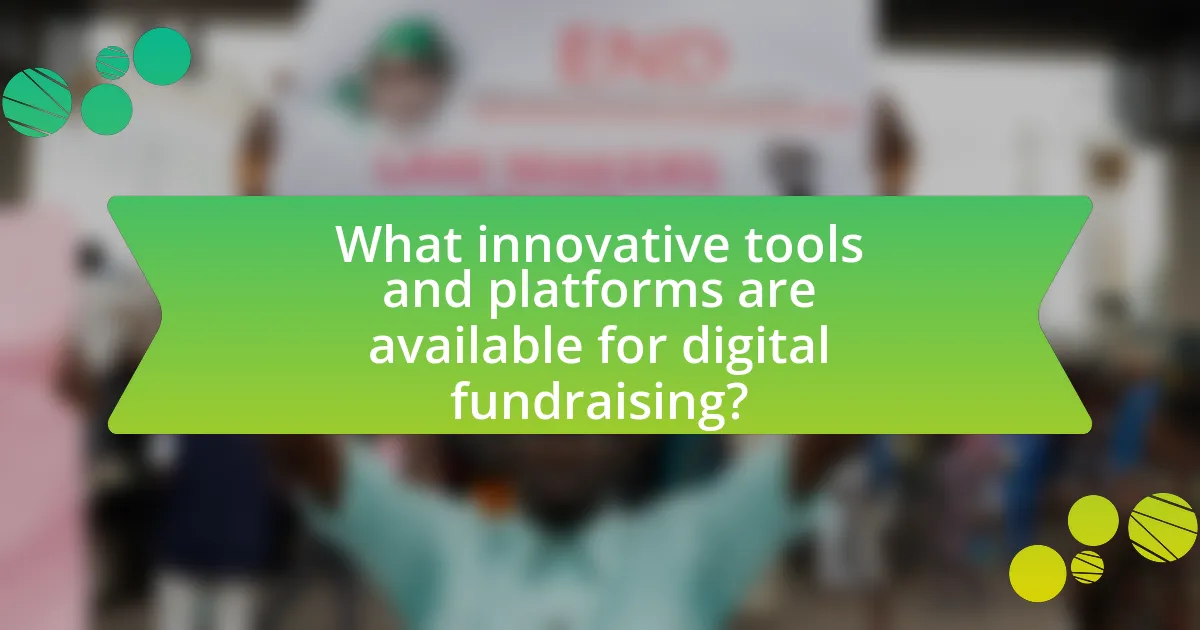
What innovative tools and platforms are available for digital fundraising?
Innovative tools and platforms available for digital fundraising include crowdfunding platforms like Kickstarter and GoFundMe, peer-to-peer fundraising tools such as Classy and DonorDrive, and social media fundraising features on platforms like Facebook and Instagram. These tools enable campaigns to reach wider audiences, facilitate easy donation processes, and leverage social networks for increased visibility. For instance, GoFundMe reported that over $9 billion has been raised through its platform since its inception, demonstrating the effectiveness of digital fundraising in mobilizing financial support.
How do different platforms cater to various fundraising needs?
Different platforms cater to various fundraising needs by offering tailored features that address specific campaign goals and donor engagement strategies. For instance, crowdfunding platforms like Kickstarter and GoFundMe allow for project-based fundraising, enabling campaigns to set specific financial targets and timelines, which appeals to grassroots supporters. In contrast, platforms like ActBlue and WinRed are designed specifically for political fundraising, providing tools for recurring donations, compliance tracking, and integration with campaign management systems, which are essential for political candidates. Additionally, social media platforms such as Facebook and Instagram facilitate peer-to-peer fundraising by allowing users to create campaigns that leverage their personal networks, thus broadening reach and engagement. These specialized functionalities demonstrate how different platforms effectively meet the diverse needs of fundraising across various contexts.
What are the advantages of using peer-to-peer fundraising platforms?
Peer-to-peer fundraising platforms offer significant advantages for political campaigns by leveraging personal networks to maximize donations. These platforms enable supporters to create individual fundraising pages, which can lead to increased engagement and a broader reach, as each supporter taps into their own social circles. According to a study by the Nonprofit Research Collaborative, campaigns utilizing peer-to-peer fundraising can see up to 30% higher fundraising totals compared to traditional methods, as personal connections often lead to increased trust and willingness to donate. Additionally, these platforms provide real-time tracking and analytics, allowing campaign managers to assess performance and adjust strategies effectively.
How can mobile apps enhance donor engagement?
Mobile apps can enhance donor engagement by providing personalized communication and streamlined donation processes. These applications allow organizations to send targeted messages, updates, and reminders directly to donors, fostering a sense of connection and involvement. For instance, a study by the Pew Research Center found that 81% of smartphone users check their devices for messages and notifications regularly, indicating that mobile apps can effectively reach and engage donors in real-time. Additionally, mobile apps often include features such as one-click donations and event registrations, which simplify the giving process and encourage more frequent contributions. This ease of use is supported by data from Blackbaud, which reports that mobile donations have increased by 205% over the past five years, demonstrating the effectiveness of mobile platforms in driving donor engagement.
What role does content creation play in digital fundraising?
Content creation is essential in digital fundraising as it engages potential donors and communicates the campaign’s message effectively. High-quality content, such as videos, articles, and social media posts, captures attention and fosters emotional connections, which are crucial for motivating contributions. According to a study by the Pew Research Center, campaigns that utilize compelling storytelling in their content see a 30% increase in donor engagement compared to those that do not. This demonstrates that well-crafted content not only informs but also inspires action, making it a vital component of successful digital fundraising strategies in political campaigns.
How can storytelling be used to connect with potential donors?
Storytelling can be used to connect with potential donors by creating emotional resonance and illustrating the impact of their contributions. Effective narratives highlight personal experiences or community challenges that the campaign aims to address, making the cause relatable and urgent. For instance, a study by the Stanford Graduate School of Business found that stories can increase engagement and donations by up to 30% compared to traditional appeals. By sharing compelling stories, campaigns can foster a sense of belonging and urgency, motivating potential donors to contribute.
What types of content are most effective for fundraising campaigns?
Storytelling content is most effective for fundraising campaigns. This type of content engages potential donors by sharing compelling narratives about the cause, beneficiaries, or impact of donations. Research indicates that campaigns utilizing storytelling can increase donations by up to 30%, as emotional connections drive donor engagement and willingness to contribute. Additionally, visual content, such as videos and infographics, enhances storytelling by making complex information more digestible and appealing, further boosting fundraising effectiveness.
How can campaigns leverage partnerships for digital fundraising?
Campaigns can leverage partnerships for digital fundraising by collaborating with organizations that share similar values and goals, thereby expanding their reach and resources. For instance, partnerships with non-profits or community groups can provide access to their donor bases, enhancing visibility and credibility. According to a study by the Nonprofit Research Collaborative, organizations that engage in partnerships report a 20% increase in fundraising success compared to those that do not. Additionally, joint campaigns can utilize shared marketing efforts, reducing costs and maximizing impact through combined social media outreach and email campaigns. This strategic collaboration not only diversifies funding sources but also fosters community engagement, leading to sustained support.
What types of organizations make ideal partners for fundraising?
Ideal partners for fundraising include nonprofit organizations, community foundations, and corporations with established corporate social responsibility programs. Nonprofit organizations often have a shared mission and audience, enhancing collaboration and outreach effectiveness. Community foundations can provide local insights and networks, facilitating targeted fundraising efforts. Corporations with strong CSR initiatives are motivated to support causes that align with their values, often providing financial resources and promotional support. According to a 2021 report by the Charitable Giving Report, partnerships with these types of organizations can increase fundraising success by up to 30%, demonstrating their effectiveness in driving contributions and engagement.
How can co-branded campaigns enhance fundraising efforts?
Co-branded campaigns can enhance fundraising efforts by leveraging the combined brand equity and audience reach of multiple organizations. This collaboration allows for a broader appeal, attracting supporters from both entities, which can significantly increase donor engagement and contributions. For instance, a study by the Association of Fundraising Professionals found that co-branded initiatives can lead to a 30% increase in fundraising revenue compared to solo campaigns. By pooling resources, co-branded campaigns also reduce marketing costs and amplify messaging, making them more effective in reaching potential donors.

What challenges do political campaigns face in digital fundraising?
Political campaigns face several challenges in digital fundraising, including donor fatigue, data privacy concerns, and competition for attention. Donor fatigue occurs when potential contributors become overwhelmed by frequent requests for donations, leading to decreased engagement and contributions. Data privacy concerns arise as campaigns collect personal information from donors, which can deter individuals from contributing due to fears of misuse or breaches. Additionally, the competition for attention is intense, as numerous campaigns vie for the same pool of online donors, making it difficult for any single campaign to stand out. These challenges can significantly impact the effectiveness of digital fundraising efforts.
How can campaigns overcome common obstacles in digital fundraising?
Campaigns can overcome common obstacles in digital fundraising by leveraging targeted messaging and data analytics to engage potential donors effectively. By utilizing data analytics, campaigns can identify donor preferences and tailor their outreach strategies accordingly, which has been shown to increase engagement rates. For instance, a study by the Pew Research Center found that personalized communication can lead to a 20% increase in donor response rates. Additionally, campaigns can implement user-friendly donation platforms that streamline the giving process, reducing friction and enhancing the donor experience. Research from the Nonprofit Research Collaborative indicates that organizations with optimized donation processes see a 30% higher conversion rate compared to those with less efficient systems.
What are the legal considerations for online fundraising?
Legal considerations for online fundraising include compliance with federal and state regulations, transparency in financial reporting, and adherence to data protection laws. Fundraisers must register with the appropriate state authorities, as many states require charities to obtain a license before soliciting donations. Additionally, organizations must provide clear information about how funds will be used and maintain accurate records of donations. The Federal Election Commission (FEC) also regulates political fundraising, imposing limits on contributions and requiring disclosure of donor information. Non-compliance can result in penalties, making it crucial for campaigners to understand and follow these legal frameworks.
How can campaigns address donor fatigue in digital fundraising?
Campaigns can address donor fatigue in digital fundraising by diversifying their communication strategies and offering meaningful engagement opportunities. By utilizing various channels such as social media, email, and personalized messaging, campaigns can keep donors informed and engaged without overwhelming them with repetitive requests for donations. Research indicates that campaigns that provide updates on the impact of donations and involve donors in decision-making processes see higher retention rates, as evidenced by a study from the Association of Fundraising Professionals, which found that 70% of donors prefer to receive information about how their contributions are making a difference. This approach not only reduces fatigue but also fosters a sense of community and belonging among donors, encouraging ongoing support.
What ethical considerations should be taken into account?
Ethical considerations in innovative digital fundraising strategies for political campaigns include transparency, data privacy, and the potential for misinformation. Transparency requires campaigns to disclose the sources of their funding and the methods used to solicit donations, ensuring that supporters understand where their contributions are going. Data privacy involves safeguarding personal information collected from donors, adhering to regulations such as the General Data Protection Regulation (GDPR), which mandates that organizations protect user data and inform individuals about how their data will be used. The potential for misinformation arises when campaigns use digital platforms to spread misleading information to influence donor behavior, which can undermine public trust and democratic processes. These considerations are critical to maintaining ethical standards in political fundraising.
How can transparency build trust with donors?
Transparency builds trust with donors by providing clear and accessible information about how their contributions are used. When organizations openly share financial reports, project outcomes, and decision-making processes, donors feel more confident that their funds are being managed responsibly. Research indicates that 85% of donors are more likely to support organizations that demonstrate transparency in their operations, as it fosters a sense of accountability and integrity. This trust is crucial in political campaigns, where donor confidence can significantly impact fundraising success and overall campaign viability.
What are the implications of data privacy in fundraising?
Data privacy in fundraising significantly impacts donor trust and compliance with regulations. Organizations must ensure that they handle personal information responsibly to maintain donor confidence and adhere to laws such as the General Data Protection Regulation (GDPR) and the California Consumer Privacy Act (CCPA). Failure to protect donor data can lead to legal repercussions, financial penalties, and damage to reputation, as evidenced by the $5 billion fine imposed on Facebook for privacy violations in 2019. Additionally, transparent data practices can enhance engagement, as donors are more likely to contribute when they feel their information is secure and used ethically.
What are the best practices for implementing innovative digital fundraising strategies?
The best practices for implementing innovative digital fundraising strategies include leveraging data analytics, utilizing social media platforms, and creating engaging content. Data analytics allows campaigns to identify donor trends and preferences, enabling targeted outreach that increases conversion rates. Social media platforms, such as Facebook and Twitter, facilitate direct engagement with potential donors, fostering community and encouraging sharing of fundraising efforts. Engaging content, including videos and interactive elements, captures attention and motivates donations, as evidenced by a 2021 study from the Digital Fundraising Institute, which found that campaigns using video content saw a 30% increase in donations compared to those that did not.
How can campaigns create a comprehensive digital fundraising plan?
Campaigns can create a comprehensive digital fundraising plan by integrating targeted messaging, leveraging multiple online platforms, and utilizing data analytics to optimize outreach. Targeted messaging ensures that the campaign’s communication resonates with specific demographics, increasing engagement and donations. Leveraging multiple online platforms, such as social media, email, and crowdfunding sites, allows campaigns to reach a broader audience and diversify their fundraising sources. Utilizing data analytics helps campaigns track donor behavior and preferences, enabling them to tailor their strategies effectively. According to a report by the Pew Research Center, 69% of adults in the U.S. use social media, highlighting the importance of these platforms in reaching potential donors.
What tips can enhance donor retention in digital fundraising?
To enhance donor retention in digital fundraising, organizations should prioritize personalized communication. Personalized emails and messages that acknowledge past contributions and express gratitude can significantly increase donor loyalty. Research indicates that personalized outreach can lead to a 29% increase in donor retention rates, as it fosters a sense of connection and appreciation among supporters. Additionally, implementing regular updates on the impact of donations helps donors feel valued and informed, reinforcing their commitment to the cause.
